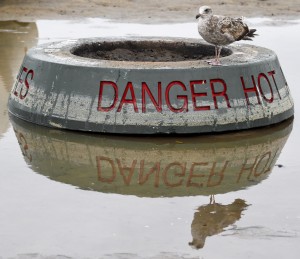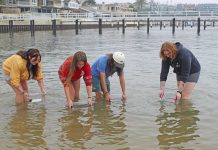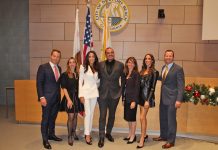
*Note: An earlier version of this story incorrectly listed Denys Oberman as a member of Friends Of The Fire Rings.*
Fire rings were once again the hot topic at a community meeting this week.
Speak Up Newport tackled the controversial issue during their monthly meeting held Thursday in the Community Room at the Newport Beach Civic Center.
City Councilman Scott Peotter and local resident Denys Oberman were the guest speakers.
Peotter gave a bit of background on the issue.
“Basically because of resident complaints they went from wood burning to getting rid of the fire pits all together,” Peotter said.
The issue then headed to the desk of California Coastal Commission and then onto the South Coast Air Quality Management District, Peotter explained. By that time, all of Southern California fire pits were brought into question. The AQMD soon amended its rule regarding wood-burning fires (Rule 444) to state that any wood burning fire pits had to be 100 feet apart or 700 feet away from homes.
Council responded by changing everything to charcoal, which the AQMD declared exempt, Peotter explained.
Even after complying with the AQMD rule, the city still had to satisfy the CCC, Peotter said.
“We worked with staff to try and come up with something that would comply with AQMD rules and Coastal,” he said.
The plan they came up with was to space them out, but that increased the footprint, he said.
Coastal Commission asked to see several options, he continued., which is why there were so many plans listed on the city website, Peotter explained.
They soon discovered that the rings don’t need to be spaced 100 feet apart if they are ADA compliant, Peotter explained, so they created a plan to make all 60 fire rings handicap accessible, which would include concrete or a walkway of some kind onto the beach. That would comply with the rules and it wouldn’t expand the footprint, he added.
“It’s one thing to move into your house and the fire rings have been there for 40 years already,” he said, “but it’s another thing if all of a sudden the fire rings move to where you’re at and they weren’t there before.”
Oberman agreed about not expanding the footprint.
They want to preserve both the tradition and the fun that the fire rings offer, but also protect the environment and health of the residents, all while keeping it in the same historical footprint boundary, Oberman said.
The fire rings are a “use that alters the physical environment of the coastal zone,” Oberman said. It creates adverse environmental health impacts, she added. They can also create nuisances, like people loitering, petty crime, litter and more.
“When we think about fire rings, those are the things to consider when we develop public policy,” Oberman said. “These are the things that people that live, work, play regularly in this environment have to deal with and they are consistently exposed to them.”
“We were driven as a community to protect the air and water quality,” she said.
People also very strongly believe in the tradition of wood-burning fire rings, she added.
Oberman spoke about the journey of the fire rings. She mentioned that the residents and the city went through extensive review and public process during the transition.
They want to find a “balanced compromise,” Oberman said.
Both preferred Plan 17, which includes charcoal and wood burning fire pits and some ADA accessible.
The meeting ended with a Q&A period. Attendees asked or commented about fire hazard with the surrounding brush, testing the air quality, science and data, the chemical analysis of the ash in the fire pits, and more.




